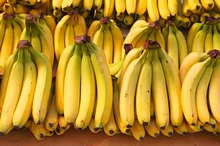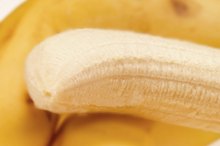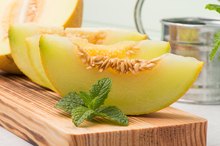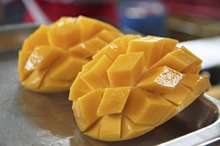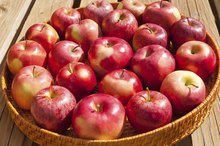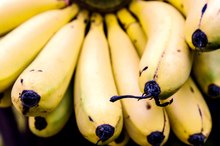Bananas and Essential Amino Acids
Bananas have a reputation as an exceptionally nutritious fruit. Constituents that support this position include fiber, potassium, fructooligosaccharide, norepinephrine and serotonin, according to Deborah Mitchell and Winifred Conkling in "The Complete Book of Nutritional Healing." Among the beneficial substances that bananas contain are amino acids 3. However, the nature and proportion of these amino acids reveal the true relationship between the nine essential amino acids and bananas 2.
Essential Amino Acids
The body uses 18 amino acids to build protein necessary to maintain its composition and functionality. It is naturally capable of producing nine of these amino acids; the other nine must derive from food. Meats can provide all nine of the essential amino acids 2. Plants can produce all 18 amino acids, but most do not produce them in the necessary proportion that the body requires them. Foods and meals that provide all of the essential amino acids are considered "complete proteins," as the body can produce protein immediately after absorbing the amino acids present in the meal, while those that do not contain the proper proportion of the nine amino acids are termed "incomplete proteins. 2"
Amino Acids in Bananas
Is Eating a Lot of Bananas Healthy?
Learn More
Bananas are incomplete proteins, although they contain all 18 amino acids. In fact, the amino acid content of bananas is generally negligible, comprising only 1.3 percent of the fruit's entire mass, according to Herbet Shelton in the book "Hygienic System Vol. II: Orthotrophy." In essence, bananas are not a significant source of amino acids. To put this in perspective, the USDA says that the amino acids most present in bananas are aspartic and glutamic acid, which aren't essential amino acids 2. Only 188 mg of aspartic acid and 231 mg of glutamic acid exist in a large banana, whereas the USDA recommends 56 g of essential amino acids per day 2.
- Bananas are incomplete proteins, although they contain all 18 amino acids.
- To put this in perspective, the USDA says that the amino acids most present in bananas are aspartic and glutamic acid, which aren't essential amino acids 2.
Other Nutrients in Bananas
The USDA reports one medium banana contains 39 mg of fat. Carbohydrates in a medium banana include:
- 3.1 g fiber
- 2.8 g sucrose
- 5.8 g glucose in the form of dextrose
- 5.7 g fructose
- 1 mg maltose
- 6.3 g starch
The minerals in a medium banana include
- 6 mg calcium
- 32 mg magnesium
- 0.31 mg iron
- 422 mg potassium
- 26 mg phosphorus
- 0.18 mg zinc
- 1 mg sodium
- 0.319 mg manganese
- 0.092 mg copper
- 1.2 mcg selenium
- 2.6 mcg fluoride
Bottom Line
The Tyrosine in Bananas
Learn More
Although all nine essential amino acids are present in bananas, the fruit is not an effective source of any of them 2. Bananas are a much more significant source of B-complex vitamins and potassium, among other nutrients. Given their carbohydrate content, bananas can also serve as a source of immediate energy.
Related Articles
References
- USDA National Nutrient Database for Standard Reference: Bananas, Raw
- Georgia State University: Essential Amino Acids
- "The Complete Book of Nutritional Healing"; Deborah Mitchell and Winifred Conkling; 2008
- SavvyVegetarian.com: How To Get Get Enough Protein In Your Veg Diet
- Hoffman JR, Falvo MJ. Protein - which is best?. J Sports Sci Med. 2004;3(3):118-30.
- Tessari P, Lante A, Mosca G. Essential amino acids: Master regulators of nutrition and environmental footprint?. Sci Rep. 2016;6:26074. doi:10.1038/srep26074
- Marsh KA, Munn EA, Baines SK. Protein and vegetarian diets. Med J Aust. 2013;199(4 Suppl):S7-S10.
- Gropper SS, Smith JL, Groff JL. Advanced Nutrition and Human Metabolism. Sixth Edition. Wadsworth Publishing Company, 2013.
- Smolin LA, Grosvenor, MB. Nutrition: Science and Applications. Third Edition. Wiley Publishing Company, 2013.
Writer Bio
Naomi Parks has been a freelancing professional since 2004. She is a biochemist and professional medical writer with areas of interest in pulmonology, pharmaceuticals, communicable diseases, green living and animals. She received her Bachelor of Arts in biological anthropology from San Francisco University and her Master of Science in biochemistry from Pace University.
